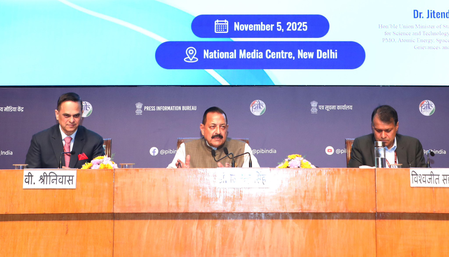
Chennai, Feb 26 (IANS) After being a major atomic power generation hub, Tamil Nadu is all set to become a major space centre in the country, with the presence of rocket/satellite makers, rocket port, space propellant park, Defence corridor and aerospace park.
Prime Minister Narendra Modi on February 28 will remotely lay the foundation stone for India’s second rocket port to be built at Kulasekarapattinam during his visit to Tuticorin District, said a senior official of the Indian Space Research Organisation (ISRO) on Monday.
ISRO is building a rocket port at Kulasekarapattinam from where small rockets laden with small satellites can be launched.
ISRO currently has the Small Satellite Launch Vehicle (SSLV) rocket with a carrying capacity of 500 kg.
The proposed rocket port is also expected to cater to the launch needs of private rocket makers.
Major space faring nations have multiple rocket launch sites. At present, India has one rocket port at Sriharikota in Andhra Pradesh with two launch pads.
“A rocket launch site should be on the east coast and near the Equator. And Tuticorin District satisfies that condition,” a former ISRO official told IANS.
Tuticorin District is a good location for a rocket that needs to fly towards the south and proximity to the sea is also important. As a matter of fact, long ago Tuticorin was considered for locating a rocket launch site.
India’s Earth observation or remote sensing satellites are flown southwards. The rockets flown from the Sriharikota rocket port in Andhra Pradesh to put satellites into the Polar orbit are not able to fly straight southwards as they have to go around Sri Lanka, resulting in higher fuel spend.
On the other hand, a straight path will result in lower fuel consumption which in turn enables the rocket to carry heavier satellites, ISRO officials said.
Former Director of ISRO, M Annadurai had told IANS, “Given the trend of launching a constellation of small satellites, the entry of small rockets — from ISRO and private players — coupled with the rocket port in Kulasekarapattinam, Tamil Nadu can become a global space sector hub.”
“Additionally, through the UN Office for Outer Space Affairs (UNOOSA), ISRO has taken the initiative to showcase to the non-space faring nations its space capabilities and also provide training to build small satellites. Those nations are interested in remote sensing satellites for their needs.
“There is a strong possibility of the first set of satellites being made and launched into orbit by India.
“Further the Defence corridor and increased drone manufacturing and usage will beef up the ecosystem for making small satellites in Tamil Nadu,” Annadurai added.
Indian private and government rocket companies can offer cost-effective launch services, as Kulasekarapattinam is an ideal location for putting a satellite into polar orbit since it is located on the east coast and is near the Equator.
With ISRO setting up its second rocket port in Kulasekarapattinam, the Tamil Nadu Government has announced that it will set up a new Space Industrial and Propellant Park near Tuticorin District on an area of 2,000 acres.
The proposed park will be set up by Tamil Nadu Industrial Development Corporation Ltd (TIDCC).
Already industrial units in Chennai, Coimbatore and other places in Tamil Nadu have been supplying components for ISRO.
Private rocket maker Agnikul Cosmos Private Ltd is based in Chennai.
The Prime Minister will also inaugurate ISRO’s Semi-cryogenics Integrated Engine and Stage Test facility at ISRO Propulsion Complex at Mahendragiri during his visit to Kerala.
The new facility will enable development of semi cryogenic engines and stages which will increase the payload capability of ISRO’s current rockets.
The facility is equipped with liquid oxygen and kerosene supply systems to test engines up to 200 tonnes of thrust.
Be that as it may, in the atomic power sector, Tamil Nadu currently has 2,440 MW commercial generation capacity out which 2,220 MW are operation (2,000 MW in Kudankulam and 440 MW at Kalpakkam) and one 220 MW plant at Madras Atomic Power Station (MAPS) is under maintenance since 2018.
The unit is expected to be operational from April 1, 2024.
That apart, another 4,000 MW of atomic power is being added in Kudankulam.
According to the Department of Atomic Energy (DAE), the integrated commissioning of the 500 MW Prototype Fast Breeder Reactor (PFBR) is in an advanced stage.
Two more 500 MW fast breeder reactors at Kalpakkam are being planned.
Recently the Prime Minister dedicated to the nation a Rs 400 crore Demonstration Fast Reactor Fuel Reprocessing Plant (DFRP), at the Indira Gandhi Centre for Atomic Research (IGCAR), at Kalpakkam.
The Fast Reactor Fuel Cycle Facility (FRFCF), being set up in Kalpakkam near here, is expected to be completed by December 2027.
The FRFCF project is executed by the Nuclear Recycle Board, Bhabha Atomic Research Centre and the DAE.
Originally budgeted at about Rs 9,600 crore, the purpose of the FRFCF is to reprocess the spent fuel of the fast breeder reactors.
(Venkatachari Jagannathan can be contacted at v.jagannathan@ians.in)
–IANS
vj/rad




